I. Jahan1, M. L. Ali2, M. A. Haydar2, M. I. Ali2, D. Paul2, S. M. A. Islam1
1Department of Physics, Jahangirnagar University, Savar, Dhaka, Bangledesh
2Health Physics and Radioactive Waste Management Unit (HPRWMU), Institute of Nuclear Science and Technology (INST), Atomic Energy Research Establishment (AERE), Bangladesh Atomic Energy Commission (BAEC), Dhaka, Bangladesh
Correspondence to: I. Jahan, Department of Physics, Jahangirnagar University, Savar, Dhaka, Bangledesh.
| Email: |  |
Copyright © 2016 Scientific & Academic Publishing. All Rights Reserved.
This work is licensed under the Creative Commons Attribution International License (CC BY).
http://creativecommons.org/licenses/by/4.0/

Abstract
The radionuclide contents and their activity concentrations have been investigated in the environmental elements such as sediment and water collected from the low-lying areas of Savar industrial zone, Dhaka, Bangladesh. The environmental samples were analyzed by gamma-ray spectrometry system using a ‘Hyper-Pure Germanium’ (HPGe) detector of 20% relative efficiency. The investigation revealed that only natural radionuclides such as 226Ra, 232Th and 40K were present in the samples and no artificial radionuclide was detected in any of the samples. The average activity concentrations of 226Ra, 232Th and 40K in sediment samples were found to be 52.22±5.48 Bq/kg, 90.65±8.75 Bq/kg and 870.45±120.45 Bq/kg, respectively. Among these the concentrations of 226Ra and 232Th are higher than the worldwide average values of 35, 30 Bq/kg, respectively whereas for 40K it was significantly higher than the worldwide average value of 400 Bq/kg. Moreover, the activity concentrations of the radionuclides in water samples did not show any major evidence of radioactive contamination. The average absorbed dose rate (D), outdoor annual effective dose (E), radium equivalent activity (Raeq) and external hazard index (Hex) were also calculated for sediment samples and were found to be 115.43 nGyh-1, 0.14 mSvyr-1, 248.67 Bq/kg and 0.67, respectively.
Keywords:
Natural Radioactivity, Artificial Radioactivity, Activity Concentrations, Absorbed Dose Rate, Outdoor Annual Effective Dose, Radium Equivalent Activity, External Hazard
Cite this paper: I. Jahan, M. L. Ali, M. A. Haydar, M. I. Ali, D. Paul, S. M. A. Islam, Distribution of Natural and Probable Artificial Radioactivity in the Sediment and Water Samples Collected from Low-Lying Areas of Savar Industrial Zone, Bangladesh, Journal of Nuclear and Particle Physics, Vol. 6 No. 2, 2016, pp. 25-34. doi: 10.5923/j.jnpp.20160602.01.
1. Introduction
The natural environment and its elements around us are the prime sources of radiation. At the very beginning when there were no sign of lives in the universe, still was full of radiation [1]. We receive radiation emitted from the floor and walls of our homes, food we eat and drink and the air we breathe [2]. The total background radiation in the earth’s environment is due to the contributions from natural (cosmic and terrestrial) as well as artificial (fall-out from nuclear weapon test, nuclear accidents, discharge from nuclear reactors etc.) radiation sources. According to UNSCEAR, about 87% of the radiation dose received by mankind is due to natural radiation sources and the remaining is due to anthropogenic radiation [1]. Natural radioactivity and the associated external exposure due to gamma radiation depend primarily on the geological and geographical conditions and appear at different levels in the soil of each region in the world [3]. Natural radionuclide in the environmental elements such as sediment and water samples contribute a significant amount of background radiation exposure to the population through inhalation and ingestion as well as through direct external exposure. Sediments are formed when rocks and/or organic materials are broken into small pieces by moving water and it plays an important role in accumulating and transporting contaminants within the geographic area [4]. The knowledge of specific activities or concentrations and distributions of the radionuclides in these materials are of interest since it provides useful information in the monitoring of environment radioactivity [5]. Such investigations can be useful for both the assessment of public dose rates and the performance of epidemiological studies, as well as to keep reference data records, in order to ascertain possible changes in the environmental radioactivity due to nuclear, industrial and other human activities [6]. Natural radioactivity arises mainly from the primordial radionuclides, such as 40K, and the radionuclides from 238U and 232Th series and their decay products, which are present at trace levels in all ground formations [7]. 137Cs is one of the fission products released into the atmosphere as a result of nuclear tests carried out since 1945 and of several accidents at nuclear power plants, including the Chernobyl one in 1986. Due to its long half-life, 137Cs is considered a major contributor to the overall collective dose from artificial radiation [8].Ashulia is one of the densely populated industrial zones located at Savar near the capital city, Dhaka, Bangladesh containing a huge number of brick fields by the side of low-lying agricultural lands. The industrial activities discharge untreated or poorly treated industrial waste water, effluent and even sludge into the surrounding environment which may contain elevated level of radioactivity. Besides, the farmers in that area are randomly using fertilizers and pesticides in agricultural lands out of their ignorance. A very little work has been done and almost no significant data are available on the radioactivity contents in the sediment and water of low-lying lands of industrial effluent- discharge zones in Bangladesh. Moreover, probable radiological impact on the people and environment due to the radioactivity content in these environmental elements needs to be determined for the radiation protection purpose.
2. Methods and Materials
2.1. Study Area
Ashulia is the area of interest in the present study, which is located at Savar upazilla in Dhaka district under Dhaka division. It is bounded by Kaliakair and Gazipur Sadar upazilas on the north, Keranigonj upazila on the west, Mohammadpur, Adabar, Darus Salam, Shah Ali, Pallabi and Turag thanas on the east, Dhamrai and Singair upazilas on the west. The study area is located in between 23°44' and 24°02' north latitudes and in between 90°11' and 90°22' east longitudes. Figure 1 shows the map of the study area under current investigation.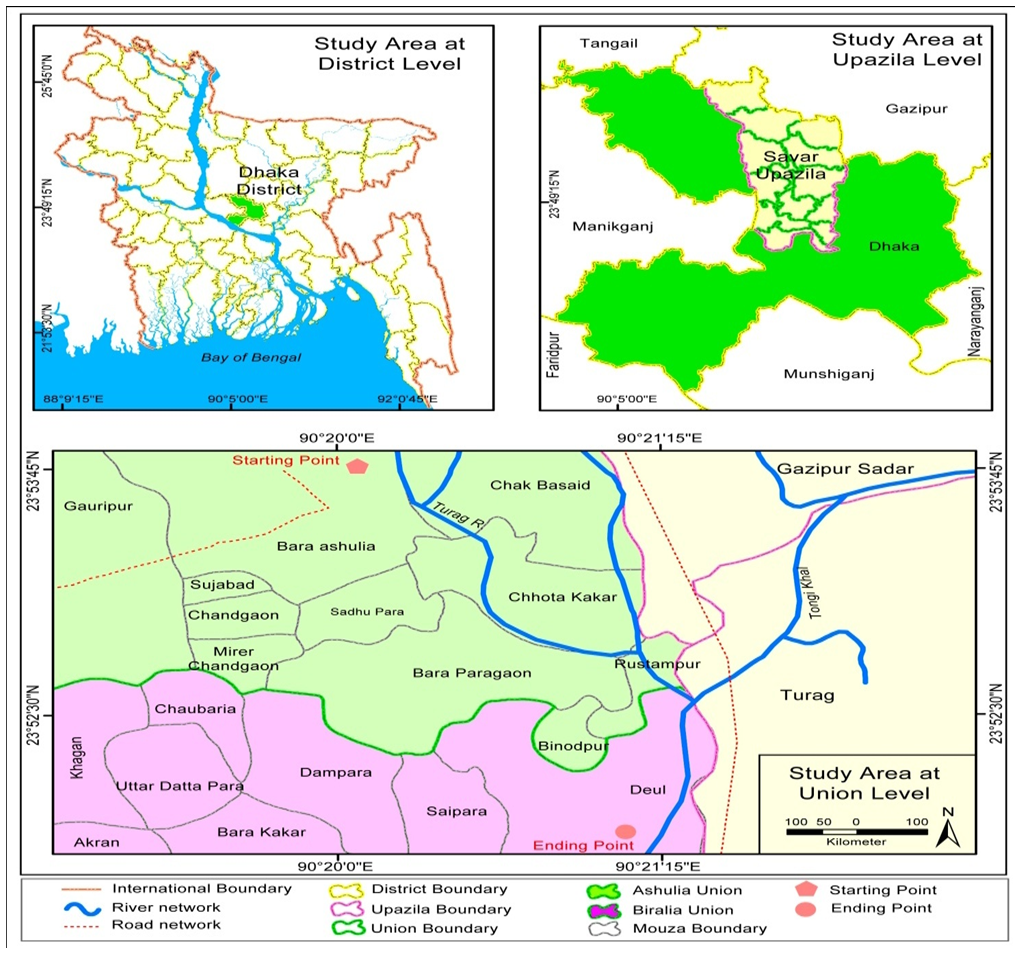 | Figure 1. Location map of the low-land area of Ashulia, Savar in Bangladesh |
2.2. Sampling Locations
A total of 26 samples namely; 14 sediments and 12 waters were collected from in and around the Turag River located at Ashulia Bazar, Ashulia, Savar. The Turag River is one of the most important rivers around Dhaka city. It is used for various purposes including discharging of the natural rain water and industrial effluents of the adjacent areas throughout the century and is a matter of great importance from economic point of view. The samples from several locations around Asulia Bridge and Majher Bridge (local name) were collected on 6 March 2014 and 2 April 2014, respectively.
2.3. Sample Collection and Preparations
A number of 7 sediment and 7 water samples from the left side of Ashulia Bridge and 3 sediment and 1water from the right side of the same bridge were collected maintaining a distance of about half kilometer from one another. In the same way 3 sediment and 3 water samples from the left of Majher Bridge and 1 sediment and 1 water from the right side of the same bridge were collected. About 0.50 - 1.00 kg of solid samples were collected from each location and preserved in plastic bags whereas water samples from each location were collected in plastic bottles. In both cases, the samples were marked with proper identification and transported to the laboratory for processing and characterization. Standard sample collection and processing protocols were followed during sampling, transport and processing of the samples [9, 10].
2.3.1. Processing of Solid Samples
Upon collection, all the sediment samples were brought to the sample preparation laboratory at the Health Physics and Radioactive Waste Management Unit, INST, AERE, Savar, Dhaka. The samples were then cleaned and dried in the sun and crushed into fine powder by using a grinder and collected after passing through 400 µm mesh screen. The homogenized samples were then dried in an oven at about 110°C for about 24 hours and the weights of the samples were recorded using an electrical balance. The samples were then transferred into sealable cylindrical plastic containers of 7 cm height and 5.5 cm in diameter with 180 ml volume, marked individually with identification parameters e.g, name and location of the sample, date of preparation and net weight. All the samples were packed into individual containers and then sealed tightly with an insulating tape around the opening of the containers for impeding the possibility of moisture contamination of air. In order to maintain radioactive secular equilibrium between Ra-226 & Th-232 with their daughter products, the packed PVC containers were stored for a period of 4 weeks.
2.3.2. Processing of Liquid Samples
Marinelli type beakers (2 litre capacity) were used to process and measure the water samples. At the start of the sample processing steps, the beakers were made contamination-free by cleaning those well using light hydrochloric acid solution and deionized water. The beakers were then dried using a temperature-controlled oven. The weights of the samples were determined from the difference of weights of sample-filled and empty beakers. Finally, the beakers filled with samples were closed by caps, wrapped with thick vinyl tape around their necks and kept for 4 weeks for achieving the secular equilibrium between gaseous and non-gaseous decay products of naturally occurring radionuclide series. The radiometric measurements of these samples were also done at the Health Physics and Radioactive Waste Management Unit, INST, AERE, Savar, Dhaka.
2.4. Measurement Set-up
The detection and measurement of radionuclides in the samples were carried out by gamma spectrometry system using a p-type co-axial HPGe detector of 93 cm3 active volume and 20% relative efficiency supplied by CANBERRA (Model GC-2018 and serial No. 0408941). The co-axial geometry with electrical contacts in the form of concentric cylinders closed at the end makes it possible to produce very large volume detector elements with excellent efficiencies for high-energy photons. The HPGe had a resolution of 2 keV at 1332 keV of Cobalt-60 gamma-ray line. The detector was coupled to a 16 k-channel analyzer. The spectra of all samples were perfectly analyzed using Genie-2000 spectra analysis software (which matched various gamma energy peaks to a library of all possible radionuclides) to calculate the concentrations of 226Ra, 232Th and 40K. The detector was enclosed in a cylindrical shielding container made of lead and iron and having a moving cover to reduce the external gamma-ray background. All the samples were counted for 10 ks. Prior to the measurement of the samples, the environmental gamma background at the laboratory site was determined with an identical empty plastic container used in the sample measurement. The energy regions selected for the corresponding radionuclides were 295 keV and 352 keV of 214Pb and 609 keV, 1120 keV and 1764 keV for 214Bi for 226Ra, 583 keV and 2614 keV of 208Tl, 911 keV and 969 keV of 228Ac for 232Th, and 1460 keV for 40K [11].
2.4.1. Calibration of the Detector
The efficiency calibration of the detector was performed by standard sources of solid and liquid matrices prepared using Ra-226 standard using identical containers used for the measurement of the samples, e.g., 2L Marinelli beakers for liquid and 180 ml plastic container for solid samples. The preparation process of standard sources had been reported elsewhere [12]. The detector efficiency calibration curves as a function of energy for both liquid and solid matrices are shown in Figure 2(a) and Figure 2(b). The energy calibration of the detector was performed by 137Cs and 60Cobalt point sources. | Figure 2(a). Efficiency curve for liquid matrix |
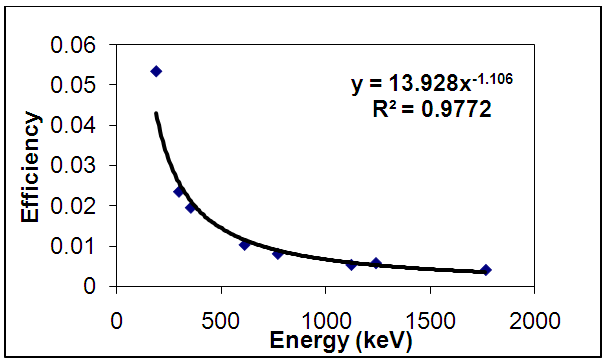 | Figure 2(b). Efficiency curve for solid matrix |
2.5. Activity Concentrations of Sediment and Water Samples
The radionuclide contents and their activity levels in each sample were measured using a calibrated HPGe detector of energy resolution of 2.0 keV at 1.33 MeV of Cobalt-60 for a period of 10,000s. The activity concentrations (A) of each radionuclide in the sample was determined by using the count per second (cps) after subtracting the background counts from the gross counts for the same counting time under the selected photo peaks, weight of the sample, the photo-peak efficiency and the gamma intensity at a specific energy as [13]: | (1) |
Where, A = Activity concentrations of the sample in Bqkg-1 or BqL-1.cps = The net counts per second= cps for the sample - cps for the background valueE = The counting efficiency of the gamma energyI = Absolute intensity of the gamma ray and W = Net weight of the sample (in kilogram or litre).The errors in the measurements were expressed in terms of standard deviation (±σ), where σ is expressed as [14]:  | (2) |
where, Ns is the sample counts measured in time Ts and Nb is the background counts measured in time Tb. The standard deviation ±σ in cps was converted into activity in Bqkg-1 according to equation (1).
2.6. Absorbed Dose Rates
The external outdoor absorbed gamma dose rates due to terrestrial gamma rays from the nuclides 226Ra,232Th & 40K at 1m above the ground level were calculated as [15]: | (3) |
where, ARa, ATh and AK are the specific activities of 226Ra, 232Th and 40K, respectively in Bqkg-1.
2.7. Outdoor Annual Effective Dose
The absorbed dose rate was converted into annual effective dose equivalent by using a conversion factor of 0.7 SvGy-1 recommended by the UNSCEAR 2000 and 0.2 for the outdoor occupancy factor by considering that the people on the average, spent 20% of their time in outdoors [16]. This was calculated by: | (4) |
2.8. Radium Equivalent Activity
The radionuclide 226Ra, 232Th and 40K are not homogeneously distributed in environmental elements. The inhomogeneous distribution from naturally occurring radionuclide is due to disequilibrium between 226Ra and its decay products. For uniformity in exposure estimates, the radionuclide concentrations are defined in terms of ‘Radium equivalent activity’ (Raeq) in Bqkg-1. This allows comparison of the specific activity of materials containing different amounts of 226Ra, 232Th and 40K according to Beretka and Mathew [17] as follows: | (5) |
2.9. External Hazard Index
The external hazard index (Hex) is defined as [18]: | (6) |
where, ARa, ATh and AK have the same meanings as in equation (3).
3. Results and Discussions
The results of the current study on the two types of samples are summarized below.
3.1. Activity Concentration of Sediment Samples
Activity concentrations of 226Ra, 232Th and 40K in sediment samples were calculated by using equation (1). The results for the same are shown in Table 1 with the uncertainty level of ± 2σ. The results are also shown graphically for independent radionuclide in the Figures 3, 4 & 5. | Figure 3. Distribution of Ra-226 in all sediment sample |
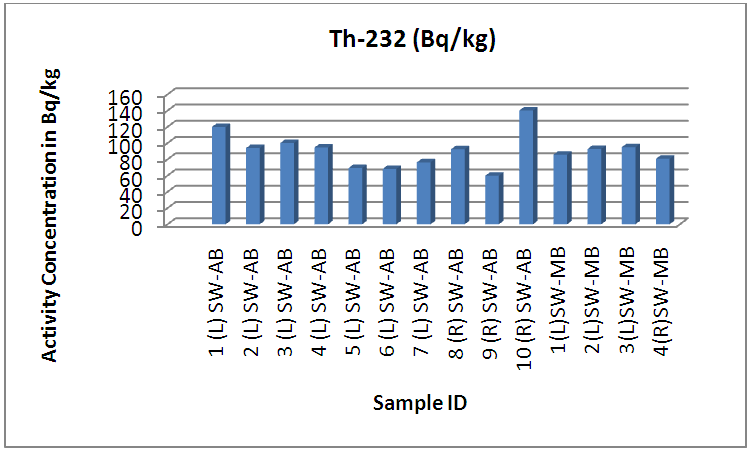 | Figure 4. Distribution of Th-232 in all sediment sample |
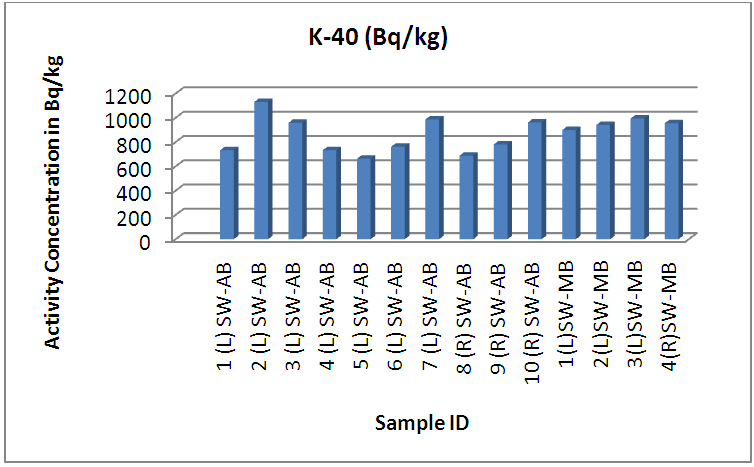 | Figure 5. Distribution of K-40 in all sediment sample |
In sediment samples the activity concentrations of 226Ra were found in the range of 32.29±3.92 to 73.94±6.51 Bqkg-1, with an average value of 52.22±5.48 Bqkg-1. This value is slightly higher than the worldwide average value of 35 Bqkg-1 [15]. The activity concentration of 232Th was found in the range of 59.76±6.78 to 140.22±10.41 Bqkg-1, with an average value of 90.65±8.75 Bqkg-1. This value is also higher than that of world average value of 30 Bqkg-1 [15].Moreover, the activity concentrations of 40K were in the range of 662.53±88.12 to 1130.53±159.26 Bqkg-1, with an average of 870.45±120.45 Bqkg-1, which is significantly higher than that of the worldwide average value of 400 Bqkg-1 [15]. Figure 6 represents the distribution of 226Ra,232Th & 40K in all the sediment samples. The samples were also analyzed to measure the activity of artificial radionuclide like 137Cs which was not found in any sample under present study. The results are reported as ND (Not Detectable) in the tables.Table 1. Activity concentration (Bqkg-1) of 226Ra, 232Th, 137Cs & 40K in all the sediment samples
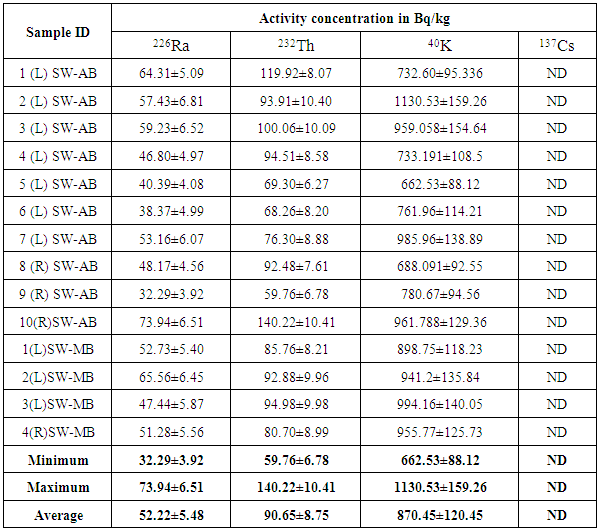 |
| |
|
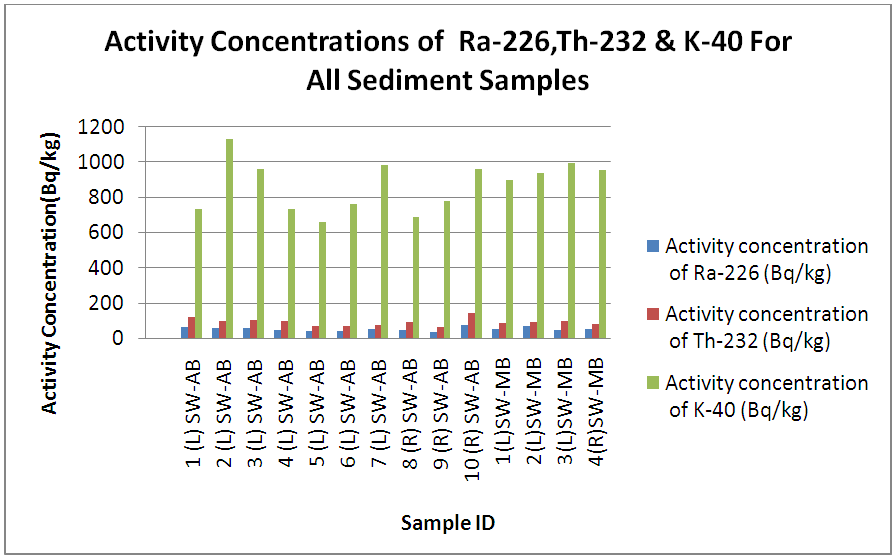 | Figure 6. Distribution of 226Ra, 232Th & 40K in all sediment samples |
3.2. Activity Concentration of Water Samples
The activity concentration of different radionuclides present in the water samples are shown in Table 2. In water samples the activity concentrations of 226Ra were found in the range of 0.31 to 2.77 BqL-1, with an average value of 1.54 BqL-1 and 232Th found in the range of 0.05 to 3.3 BqL-1 with an average value of 1.675 BqL-1. 40K and 137Cs were not found in any of the samples. The rest of the radionuclides in almost all the water samples were below the detection limit. Therefore, the activity contents of the water samples collected from study area did not show any major evidence of radioactive enhancement.Table 2. Activity concentration (BqL-1) of 226Ra, 232Th, 137Cs & 40K in all the water samples
 |
| |
|
A comparison of activity concentration values with those of other countries is given in Table 3.Table 3. Activity concentration (Bqkg-1) of 226Ra, 232Th, 40K & 137Cs in sediment samples worldwide
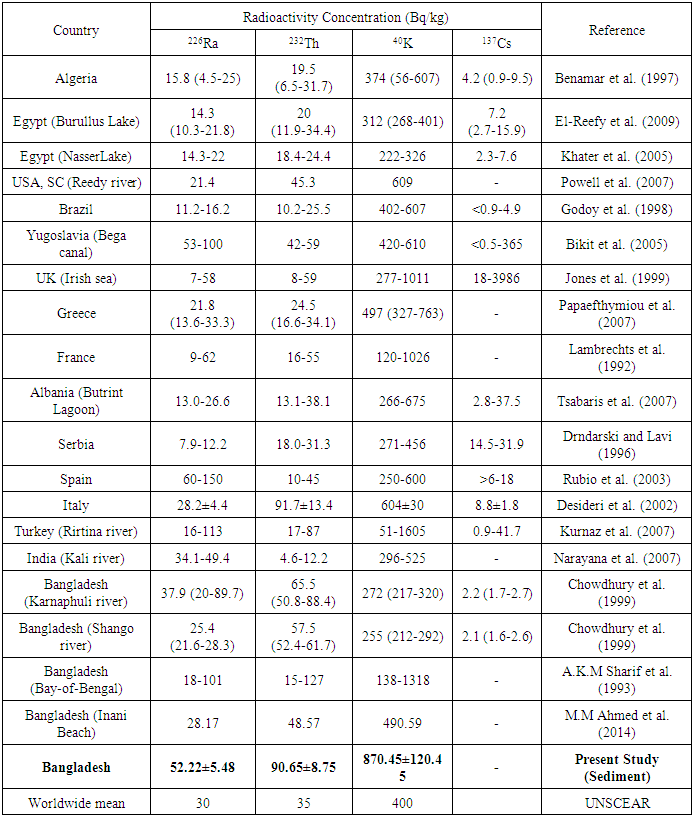 |
| |
|
3.3. Radiological Indices
In order to assess the health effects, the radiation hazards such as absorbed dose rate (D), outdoor annual effective dose (E), radium equivalent activity (Raex) and external hazard index (Hex) have been calculated from the activity concentrations of 226Ra, 232Th and 40K and the values are shown in Table 4. The graphical representation of these values is also shown in Figure 7.Table 4. Absorbed dose rate, D (nGyh-1), outdoor annual effective dose, E (mSvyr-1), radium equivalent activity (Raeq) and external hazard index (Hex) of all sediment samples
 |
| |
|
 | Figure 7. Radiological Hazard indices for all sediment samples |
From Table 4 it is seen that the absorbed dose rate for sediment samples were varied from 83.80 to 159.25 nGyh-1 with an average of 115.43 nGyh-1 and this value is higher than the world average of 55 nGyh-1 [15]. On the other hand, the outdoor annual effective dose was ranged from 0.10 to 0.19 mSvyr-1 with an average value of 0.14 mSvyr-1 which is less than the world average value of 0.48 mSvyr-1 [15]. Moreover, the mean value of radium equivalent activity was found to be 248.67 Bqkg-1 which falls below the world average value of 370 Bqkg-1 [15]. Furthermore, the mean value of external radiation hazard index was found to be 0.67 which is also far below the unity indicating the non-hazardous category of the samples.The values of hazard indices confirmed that there is no possibility of immediate health effect for human to live and work at that area due to the radioactivity present in the environmental elements and the study also reveals that there is yet no significant radiological impact on the environment. The values found from the current study were compared with those of other published data at home and abroad and found that the radioactivity level was within the safety limit.
4. Conclusions
The radionuclide contents, activity concentrations and radiological impact of the sediment and water samples were investigated in the present study.The results indicate that only the natural radionuclides were present in the samples. The activity concentration of man-made radionuclides such as 137Cs, 90Sr etc. were below the minimum detectable limit. This implies that the samples studied were free from artificial radionuclide. The natural radioactivity concentrations of 226Ra, 232Th for the sediment samples were slightly higher than the worldwide average values but for 40K, it was significantly higher than the worldwide average value. The activity concentrations of water samples did not show any major evidence of radioactive contamination. The average absorbed dose rates were higher than worldwide average value for sediment samples. Whereas, outdoor annual effective dose, the radium equivalent activity and external hazard indices were less than the world average values. The current result was analyzed and compared with the results of similar studies performed in other countries and in different places in Bangladesh. All these investigations indicated that there was no probability of immediate health effect on the member of public due to natural or artificial radioactivity present in the area under study.
ACKNOWLEDGEMENTS
The authors are thankful to the authority of Atomic Energy Research Establishment (AERE), Savar, Dhaka, Bangladesh for giving the permission to carry out this research work at Health Physics & Radioactive Waste Management Unit (HPRWMU). The authors also like to thank the technical support staffs of HPRWMU, INST for their help in conducting the study.
References
| [1] | V. Kannan, M. P. Rajan, M. A. Lyengar, and R. Ramesh, “Distribution of Natural and Anthropogenic Radionuelides in Soil and Beach sand Samples of Kalpakkam (India)”, Applied Radiation and Isotopes, vol. 57, pp. 109-119, 2002. |
| [2] | M. M. Hasan, M. I. Ali, D. Paul, M. A. Haydar, S. M. A Islam, “Measurement of Natural Radioactivity in Coal, Soil and Water Samples collected from Barapukuria Coal Mine in Dinajpur District of Bangladesh”, Journal of Nuclear and Particle physics, vol. 3, No. 3, 2013. |
| [3] | M. Abusini, K. Al-ayasreh and J. Al-Jundi, “Determination of Uranium, Thorium and Potassium Activity concentrations in Soil Cores in Araba Valley, Jordan”, Radiation Protection Dosimetry, vol. 128, No. 2, pp. 213-216, 2008. |
| [4] | H. I. El-Reefy, T. Sharshar, T. Elnimr, H. M. Badran, “Distribution of gamma-ray emitting radionuclides in the marine environment of the Burullus Lake: Bottom sediments”, Environ Monit. Assess, vol. 169, pp. 273-284, 2010. |
| [5] | P. Kessaratikoon and S. Awaekechi, “Natural radioactivity measurement in soil samples collected from municipal area of Hat Yai district in Songkhla province, Thailand”, KMITL Sci. J., vol. 8, No. 2, July-Dec, 2008. |
| [6] | N. Akhtar, M. Tufail and M. Ashraf, “Natural environmental radioactivity and estimation of radiation exposure from saline soils”, International Journal of Environmental Science & Technology, vol.1, No.4, pp. 279-285, Winter 2005. |
| [7] | M. Tzortzis, E. Svoukis, and H. Tsetos, “A comprehensive Study of Natural Gamma Radioactivity levels and Associated Dose Rates from Surface Soils in Cyprus”, Radiation Protection Dosimetry, vol. 109(3), pp. 217-224, 2004. |
| [8] | S. Dimovska, T. Stafilov, R. Sajn and M. Frontasyeva, “Distribution of Some Natural and Man-Made Radionuclides in Soil from the City of Veles (Republic Of Macedonia) and Its Environs”, Radiation Protection Dosimetry, vol. 138, No. 2, pp. 144-157, 2010. |
| [9] | Contaminated Land Management Guidelines No. 5, Guideline on Site Investigation and Analysis of Soil, Ministry for the Environment, New Zealand. Web-site: http://www.mfe.govt.nz/publications/ser/hazardous/contaminated-land-mgmt-guidelines-no5/html. |
| [10] | Soil sampling for environmental contaminants, IAEA-TECDOC-1415, October 2004. |
| [11] | C. E. Roessier, Z. A. Smith, W. E. Bloch and R. J Prince, “Uranium and Radium in Floride Phosphate Materials”, Health Phys. vol. 37, pp. 269-277, 1970. |
| [12] | S. Harb, K. S. Din and A. Abbady, “Study of efficiency calibrations of HPGe detectors for radioactivity measurement of environmental samples”, Proceedings of the 3rd Environmental Physics Conference, Aswan, Egypt. 19-23 Feb. 2008. |
| [13] | M. A. Usif and A. E. Taher, “Radiological assessment of Abu-Tartur phosphate, western desert Egypt”, Radiation Protection Dosimetry, vol. 130, pp. 228-235, 2008. |
| [14] | G. F. Knoll, Radiation Detection and Measurement, 3rd edition, New York, 1998. |
| [15] | UNSCEAR, Sources and Effects of Ionizing Radiation, Report of the United Nations Scientific Committee on the Effects of Atomic Radiation to the General Assembly, United Nations, New York, USA, (2000). Annex. |
| [16] | K. Debertin and R. G. Helmer, Gamma and X-ray Spectrometry with Semiconductor Detectors, North Holland, 1988. |
| [17] | J. Beretka, and P. J. Mathew, “Natural radioactivity of Australian buildings, materials, industrial wastes and by products”, Health Physic, vol. 48, No.1, pp. 87-95, 1985. |
| [18] | X. Lu, and Z. Xiolan, “Measurement of natural radioactivity in sand samples collected from the Booje Weithe Sand park, China”, Environ, Geol. vol. 50, pp. 977-988, 2006. |

















 Abstract
Abstract Reference
Reference Full-Text PDF
Full-Text PDF Full-text HTML
Full-text HTML


